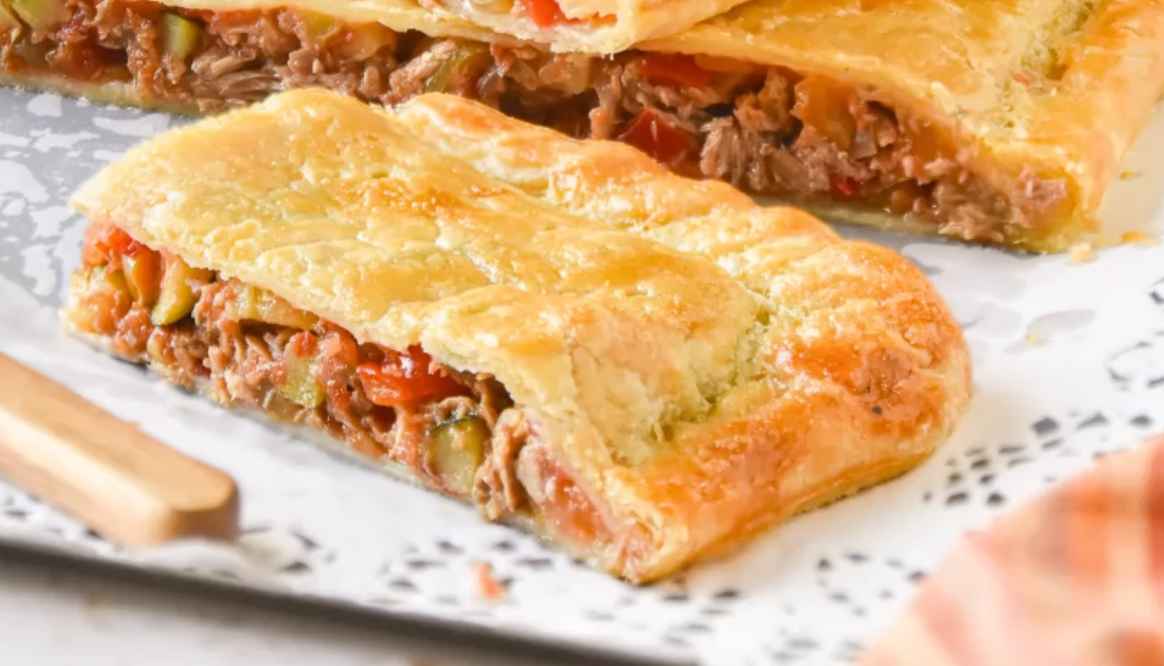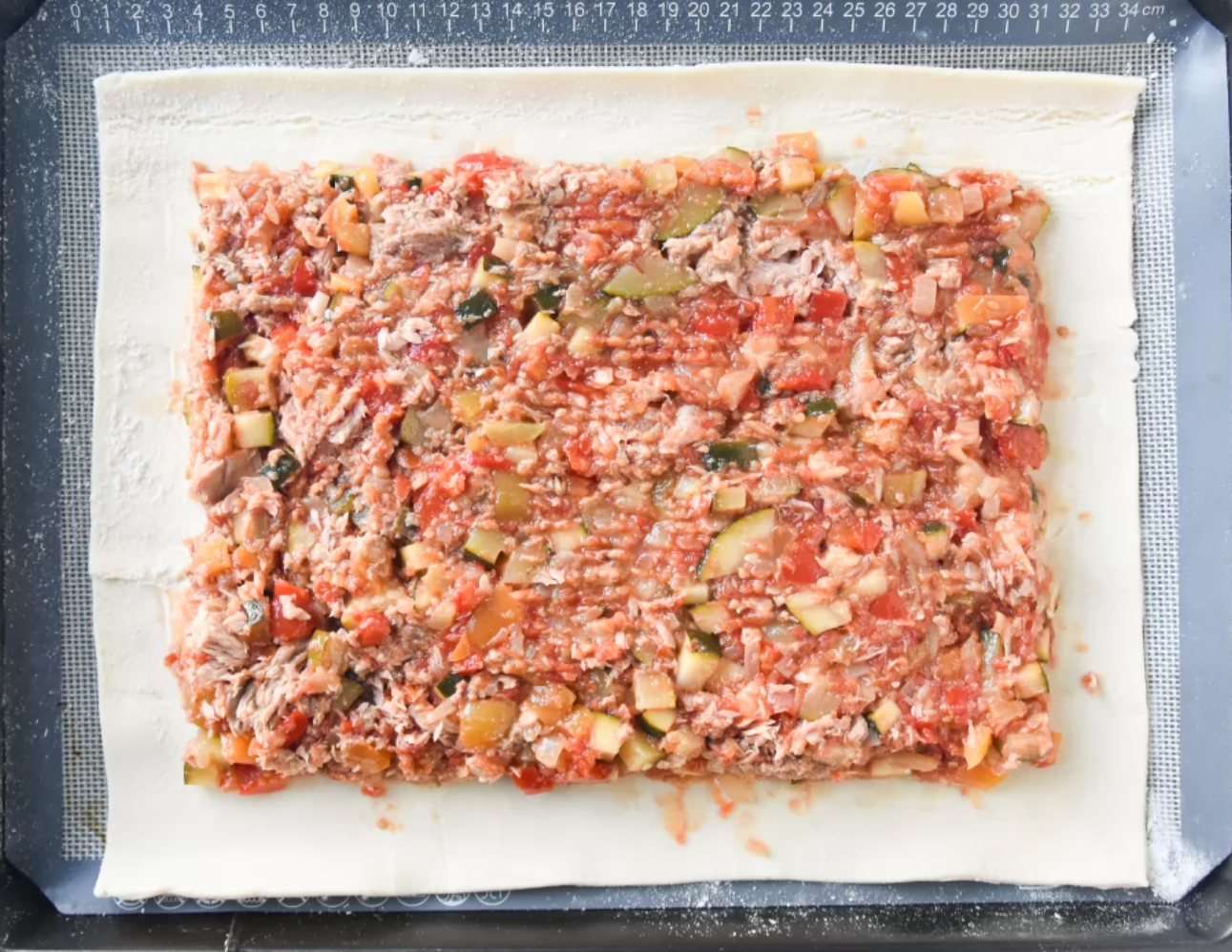Empanadas are a cornerstone of Spanish cuisine, beloved parcels of pastry encasing a variety of delicious fillings. From Galicia in the north-west, famous for its large, often seafood-filled pies, to smaller, individual 'empanadillas' found across the country, these versatile bakes are perfect for sharing, picnics, parties, or simply a satisfying meal.
Today, we're diving into a particularly popular and flavourful combination: Tuna and Pisto Empanada. Imagine flaky, golden pastry giving way to a rich, savoury filling of slow-cooked Mediterranean vegetables (the glorious pisto) mingled with tender tuna. It’s a classicfor a reason – comforting, packed with flavour, and surprisingly straightforward to make at home.

While you can certainly use shop-bought pastry for convenience, crafting your own dough adds an extra layer of satisfaction and results in a uniquely tender yet sturdy crust, perfectly designed to hold the generous filling. Let's explore how to bring this Spanish favourite to your kitchen table.
Understanding the Key Components
Before we begin, let's break down what makes this empanada special:
The Dough (Masa): The traditional dough for Spanish empanadas is often enriched with oil (like olive oil) and sometimes a touch of white wine or even lard, giving it a character distinct from standard shortcrust or puff pastry. It needs to be rolled thinly but remain strong enough not to tear under the weight of the filling. It bakes up beautifully crisp at the edges and slightly softer where it meets the filling. Of course, if time is short, good quality ready-made puff or shortcrust pastry works well too, offering different textures (flaky or crumbly, respectively).
The Filling (Relleno):
Pisto: This is the heart of the filling. Pisto Manchego, hailing from the La Mancha region of Spain, is a vibrant vegetable stew similar in concept to French ratatouille but often simpler. It typically involves slowly simmering onions, peppers, courgettes, and tomatoes in olive oil until soft, sweet, and concentrated in flavour. Allowing the vegetables to cook down properly is key to developing depth.
Tuna: Good quality tinned tuna is essential. Whether you choose tuna in olive oil (drain it very well!) or brine (drain well and perhaps add a drizzle of extra virgin olive oil to the filling), it provides a savoury, umami counterpoint to the sweet vegetables. Flake it gently into the cooled pisto.
Optional Additions: Hard-boiled eggs are a very common and traditional addition to this type of empanada filling, adding extra substance and richness. Simply chop them and fold them in with the tuna.
Ingredients
Here’s what you’ll need to gather:
For the Dough (Masa):
500g Plain Flour (plus extra for dusting)
100ml Olive Oil (a mild one works well)
100ml Dry White Wine (at room temperature)
100ml Warm Water
1 tsp Salt
1 tsp Caster Sugar (optional, helps with browning)
1 Egg Yolk (for kneading, optional for richness)
For the Filling (Relleno):
1 Large Onion (approx. 200g), finely chopped
1 Green Pepper, deseeded and finely chopped
1 Red Pepper, deseeded and finely chopped
1 Large Courgette (approx. 300g), diced
400g Tinned Chopped Tomatoes (good quality)
200g Tinned Tuna (in oil or brine), thoroughly drained and flaked
2-3 tbsp Olive Oil (for cooking the pisto)
1 tsp Sugar (to balance tomato acidity)
Salt, to taste
Black Pepper, to taste
(Optional) 2 Hard-Boiled Eggs, peeled and chopped

For Assembly:
1 Medium Egg, beaten (for egg wash)
Let's break down the process into manageable stages:
1. Make the Dough:
In a large bowl, combine the plain flour, salt, and optional caster sugar. Make a well in the centre.
Pour the olive oil, white wine, warm water, and optional egg yolk into the well.
Using your hands or a wooden spoon, gradually mix the wet ingredients into the dry until a shaggy dough forms.
Turn the dough out onto a lightly floured surface. Knead for about 8-10 minutes until it becomes smooth, elastic, and no longer sticky. Add a tiny bit more flour if it’s excessively sticky, or a splash more water if it feels too dry.
Form the dough into a ball, place it back in the bowl, cover with cling film or a damp cloth, and let it rest at room temperature for at least 30 minutes (or up to an hour). This allows the gluten to relax, making it easier to roll out later.
2. Prepare the Pisto:
While the dough rests, make the pisto. Heat the 2-3 tablespoons of olive oil in a large frying pan or saucepan over medium heat.
Add the chopped onion and peppers. Sauté gently for about 10-15 minutes, stirring occasionally, until softened and the onion is translucent. Don't rush this step; sweating the vegetables slowly builds flavour.
Add the diced courgette and cook for another 5-7 minutes, stirring, until it begins to soften.
Pour in the tinned chopped tomatoes, add the teaspoon of sugar, and season with salt and freshly ground black pepper to your taste.
Bring the mixture to a gentle simmer, then reduce the heat to low, cover loosely, and let it cook for at least 20-30 minutes, or until the vegetables are very tender and the sauce has thickened and reduced. Stir occasionally to prevent sticking. The goal is a rich, fairly dry stew – excess liquid will make the empanada soggy.
Once cooked, remove the pisto from the heat and let it cool completely. This is crucial; adding hot filling to pastry will melt it.
3. Assemble the Filling:
Once the pisto is completely cool, gently fold in the thoroughly drained and flaked tuna.
If using, fold in the chopped hard-boiled eggs. Taste and adjust seasoning if necessary.

4. Assemble the Empanada:
Preheat your oven to 200°C (180°C Fan/Gas Mark 6). Line a large baking tray with baking parchment.
Divide the rested dough into two portions: one slightly larger (about two-thirds) for the base, and the smaller one (about one-third) for the top.
On a lightly floured surface, roll out the larger portion of dough into a thin rectangle or circle, large enough to cover the base of your baking tray with a slight overhang. Carefully transfer the dough to the prepared baking tray.
Spoon the cooled tuna and pisto filling evenly over the dough base, leaving a 2-3 cm border clear all around.
Roll out the smaller portion of dough to create the lid, making it slightly larger than the filling area.
Brush the clear border of the base dough with a little water or some of the beaten egg.
Carefully place the top layer of dough over the filling. Press down gently around the edges to seal the two layers together.
Trim any excess dough from the edges. Crimp the edges securely to ensure the filling doesn't leak during baking. You can do this by pressing down with the tines of a fork, or by folding the edge over itself repeatedly to create a decorative, rope-like border (known as 'repulgue' in Spanish).
Cut a small slit or a couple of small holes in the centre of the empanada lid to allow steam to escape during baking. You can also use leftover dough scraps to create decorative shapes on top if you wish.
Brush the entire top surface of the empanada evenly with the beaten egg wash. This will give it a beautiful golden colour and shine.

5. Bake the Empanada:
Place the baking tray in the preheated oven.
Bake for 30-40 minutes, or until the pastry is deeply golden brown, crisp, and cooked through. Cooking time may vary slightly depending on your oven. If it seems to be browning too quickly on top, you can loosely tent it with foil for the last part of baking.
Once baked, remove the empanada from the oven and let it cool on the baking tray for at least 10-15 minutes before slicing and serving. This allows the filling to set slightly and makes it easier to cut.
Tips for Success and Variations
Cool Filling is Key: Ensure the pisto is completely cool before adding the tuna and assembling the empanada to prevent a soggy bottom.
Drain Tuna Well: Excess oil or water from the tuna will make the filling too wet. Squeeze it gently if necessary.
Pastry Options: If making your own dough seems daunting, ready-rolled puff pastry will give a flaky, light result, while ready-rolled shortcrust pastry offers a more crumbly, biscuit-like texture. Follow the packet instructions for baking times and temperatures, adjusting as needed.
Make Ahead: The pisto can be made a day or two in advance and stored in the fridge. The entire assembled empanada can also be refrigerated for a few hours before baking (just add the egg wash right before it goes in the oven). Cooked empanada stores well in the fridge for 2-3 days and can be gently reheated or enjoyed cold.
Freezing: You can freeze the baked and cooled empanada whole or in slices, well-wrapped. Reheat from frozen in a moderate oven until heated through. You can also potentially freeze the unbaked empanada, though the pastry texture might be slightly affected upon baking.
Filling Variations: This recipe is wonderfully adaptable. Try swapping the tuna for cooked shredded chicken, minced beef (cooked with the pisto base), chorizo, or other tinned fish like sardines or mackerel. For a vegetarian version, simply omit the tuna and perhaps add some chickpeas or white beans to the pisto for substance.
Egg Wash Alternatives: If you don't have an egg, you can brush the top with milk for a golden finish.
Serving Suggestions
Tuna and Pisto Empanada is fantastic served warm from the oven, but it's also delicious at room temperature, making it ideal for packed lunches or picnics.
Cut it into generous squares or wedges. It's substantial enough to be a meal in itself, but it pairs beautifully with a simple green salad dressed with a light vinaigrette, or perhaps some Spanish olives on the side.
Making a Tuna and Pisto Empanada from scratch is a rewarding process. It fills your kitchen with wonderful aromas and results in a truly satisfying bake. It’s a taste of authentic Spanish home cooking—robust, flavourful, and perfect for sharing with family and friends. Whether you follow the recipe precisely or adapt it with your favourite variations, this empanada is sure to become a much-loved staple. Enjoy!